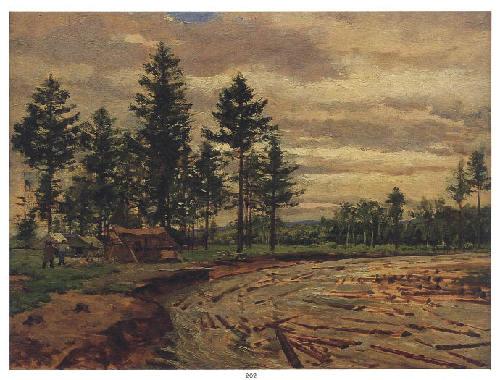Wu Zuoren’s Yellow Blooms
 |
| Greater Khingan, oil on canvas. China Guardian |
By the time Yellow Blooms was painted, Wu already had an established style and reputation in China’s art circles. Born in Suzhou City of Jiangsu Province, famous for its beautiful gardens, he dropped out of school at a young age and taught himself painting. In 1926, he enrolled at a vocational college to study art. In the following years he took painting courses at three universities in Shanghai and Nanjing. Among his tutors was one of the greatest artists in modern Chinese history, Xu Beihong (1895-1953). In 1929, the 22-year-old Wu published one of his sketches in Southern China Weekly – Warship below the God of Peace, which made him well known in the Chinese art scene.
In 1930 Wu traveled to Paris and Brussels for further studies. In his second year at Belgium’s Royal Academy of Fine Arts, he was awarded first place in an oil painting competition and honored as a Laureate Student. The school’s then president Alfred Bastien thought highly of Wu’s originality, remarking that his works were characterized by neither the style of influential French painter Vlaminck nor traditional Chinese painting but had their own distinctive features.
In 1935, upon the invitation of Xu Beihong, Wu returned to China to teach in the Art Department of the Central University, now known as Nanjing University. During the War of Resistance Against Japanese Aggression, Wu led a group of painters who ventured to the frontline and captured the action on canvas. They also made many trips to the great wildernesses in Shaanxi, Gansu and Qinghai and Tibet, where they collected creative materials and copied the murals in the Dunhuang grottoes.
After 1946 Wu became a member of both the teaching and managerial staff at Peking State Academy of Arts, today’s Central Academy of Fine Arts. The following year he held several well-received exhibitions in the U.K., France and Switzerland. With a distinguished global reputation, he was recognized both by France’s Ordre des Arts et des Lettres in 1984 and the Belgian royal family, who awarded him a medal the following year.
Early on in his career Wu mainly focused on sketching and oil painting. In his twilight years he returned to his roots of traditional Chinese painting. During both periods Wu’s combination of Chinese and Western techniques conveyed his breadth of vision and depth of meaning.
Unfortunately, few of his early oil paintings, such as Boat Tracker (Qianfu) and Caucus Meeting (Xiaozu Hui), have survived the decades. During the Japanese occupation works his like Sowing Seeds (Bo Zhong) and The Mother during the Air Attack (Kongxi Xiade Muqin) took on a more political theme, exposing Japanese war crimes. With the founding of the People’s Republic the emotion expressed in his paintings became more positive, and he created a huge body of landscape paintings, including Desert Turning to Oasis (Shamo Bian Lüzhou) and Sanmen Gorge (Sanmen Xia). Wu also created many portraits, which are best represented by Qi Baishi and Korean Girls.
Today, Wu’s works are sought after in the art market and at auctions. Estimates suggest that around two thirds of his 5,242 works that appeared at auctions have been hammered out, fetching a total of RMB 506 million.

